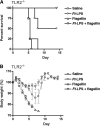Role of TLR signaling in Francisella tularensis-LPS-induced, antibody-mediated protection against Francisella tularensis challenge
- PMID: 21750122
- PMCID: PMC3177696
- DOI: 10.1189/jlb.0111014
Role of TLR signaling in Francisella tularensis-LPS-induced, antibody-mediated protection against Francisella tularensis challenge
Abstract
Immunization with Ft-LPS provokes an antigen-specific, B-1a cell-derived antibody response that protects WT mice against an otherwise lethal challenge with Ft LVS. However, this same regimen offers limited protection to TLR2(-/-) mice, despite production of WT levels of anti-Ft-LPS antibodies. As Ft-LPS exhibits no TLR2 agonist activity, and macrophage-induced cytokine production in response to Ft LVS is overwhelmingly TLR2-dependent, we hypothesized that treatment of TLR2(-/-) mice with an alternative, MyD88-dependent TLR agonist would compensate for reduced recognition of Ft LVS in TLR2(-/-) mice and thereby, restore Ft-LPS-mediated protection. Administration of the nontoxic TLR4 agonist, synthetic Escherichia coli MPL, at the time of Ft-LPS immunization or Ft LVS challenge, fully protected TLR2(-/-) mice, whereas treatment of WT or TLR2(-/-) mice with MPL alone conferred partial protection. The TLR5 agonist, flagellin, also synergized with Ft-LPS to protect TLR2(-/-) mice from lethal Ft LVS challenge. In contrast to Ft LVS, Ft-LPS pretreatment failed to protect mice against i.n. challenge with Ft Schu S4, whereas MPL, administered in the absence or presence of Ft-LPS, conferred significant, albeit partial, protection. MPL treatment of macrophages increased the uptake of Ft LVS and decreased intracellular bacterial survival while shifting the macrophage-differentiation phenotype from "alternatively activated" to "classically activated". Collectively, our data suggest that optimal, Ft-LPS-mediated protection against Ft LVS infection requires two discrete events, i.e., production of Ft-LPS-specific antibody, as well as TLR-mediated macrophage activation, to fully control Francisella infection.
Figures






Similar articles
-
Immunologic consequences of Francisella tularensis live vaccine strain infection: role of the innate immune response in infection and immunity.J Immunol. 2006 Jun 1;176(11):6888-99. doi: 10.4049/jimmunol.176.11.6888. J Immunol. 2006. PMID: 16709849
-
Antigen-specific B-1a antibodies induced by Francisella tularensis LPS provide long-term protection against F. tularensis LVS challenge.Proc Natl Acad Sci U S A. 2009 Mar 17;106(11):4343-8. doi: 10.1073/pnas.0813411106. Epub 2009 Feb 26. Proc Natl Acad Sci U S A. 2009. PMID: 19251656 Free PMC article.
-
Toll-like receptor 2-mediated signaling requirements for Francisella tularensis live vaccine strain infection of murine macrophages.Infect Immun. 2007 Aug;75(8):4127-37. doi: 10.1128/IAI.01868-06. Epub 2007 May 21. Infect Immun. 2007. PMID: 17517865 Free PMC article.
-
Monocyte/macrophage inflammatory response pathways to combat Francisella infection: possible therapeutic targets?Front Cell Infect Microbiol. 2014 Feb 21;4:18. doi: 10.3389/fcimb.2014.00018. eCollection 2014. Front Cell Infect Microbiol. 2014. PMID: 24600590 Free PMC article. Review.
-
The structure and function of Francisella lipopolysaccharide.Ann N Y Acad Sci. 2007 Jun;1105:202-18. doi: 10.1196/annals.1409.006. Epub 2007 Mar 29. Ann N Y Acad Sci. 2007. PMID: 17395723 Free PMC article. Review.
Cited by
-
Circulating T Cells Are Not Sufficient for Protective Immunity against Virulent Francisella tularensis.J Immunol. 2022 Mar 1;208(5):1180-1188. doi: 10.4049/jimmunol.2100915. Epub 2022 Feb 11. J Immunol. 2022. PMID: 35149529 Free PMC article.
-
Hematopoietic MyD88 and IL-18 are essential for IFN-γ-dependent restriction of type A Francisella tularensis infection.J Leukoc Biol. 2017 Dec;102(6):1441-1450. doi: 10.1189/jlb.4A0517-179R. Epub 2017 Sep 26. J Leukoc Biol. 2017. PMID: 28951422 Free PMC article.
-
Lipopolysaccharide Recognition in the Crossroads of TLR4 and Caspase-4/11 Mediated Inflammatory Pathways.Front Immunol. 2020 Nov 27;11:585146. doi: 10.3389/fimmu.2020.585146. eCollection 2020. Front Immunol. 2020. PMID: 33329561 Free PMC article. Review.
-
Kdo hydrolase is required for Francisella tularensis virulence and evasion of TLR2-mediated innate immunity.mBio. 2013 Feb 12;4(1):e00638-12. doi: 10.1128/mBio.00638-12. mBio. 2013. PMID: 23404403 Free PMC article.
-
Temporal transcriptional response during infection of type II alveolar epithelial cells with Francisella tularensis live vaccine strain (LVS) supports a general host suppression and bacterial uptake by macropinocytosis.J Biol Chem. 2013 Apr 12;288(15):10780-91. doi: 10.1074/jbc.M112.362178. Epub 2013 Jan 15. J Biol Chem. 2013. PMID: 23322778 Free PMC article.
References
-
- Saslaw S., Eigelsbach H. T., Wilson H. E., Prior J. A., Carhart S. (1961) Tularemia vaccine study. I. Intracutaneous challenge. Arch. Intern. Med. 107, 689–701 - PubMed
-
- Saslaw S., Eigelsbach H. T., Prior J. A., Wilson H. E., Carhart S. (1961) Tularemia vaccine study. II. Respiratory challenge. Arch. Intern. Med. 107, 702–714 - PubMed
-
- Christopher G. W., Cieslak T. J., Pavlin J. A., Eitzen E. M., Jr. (1997) Biological warfare. A historical perspective. JAMA 278, 412–417 - PubMed
-
- Dennis D. T., Inglesby T. V., Henderson D. A., Bartlett J. G., Ascher M. S., Eitzen E., Fine A. D., Friedlander A. M., Hauer J., Layton M., Lillibridge S. R., McDade J. E., Osterholm M. T., O′Toole T., Parker G., Perl T. M., Russell P. K., Tonat K. (2001) Tularemia as a biological weapon: medical and public health management. JAMA 285, 2763–2773 - PubMed
-
- Harris S. (1992) Japanese biological warfare research on humans: a case study of microbiology and ethics. Ann. N. Y. Acad. Sci. 666, 21–52 - PubMed
Publication types
MeSH terms
Substances
Grants and funding
LinkOut - more resources
Full Text Sources
Other Literature Sources
Research Materials

